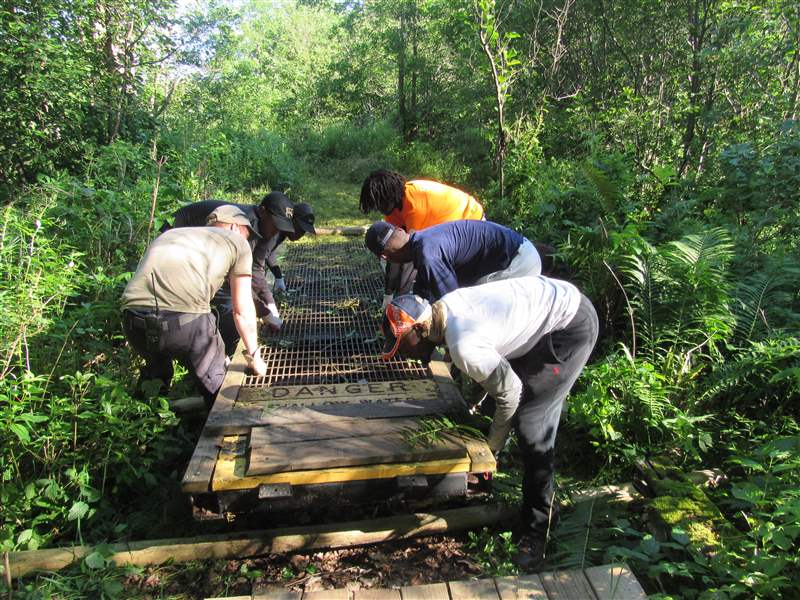
OUTDOORS
Upper Peninsula project brings big-city youths into the outdoors
9/11/2017
A group of Detroit teens spent part of its summer in the Upper Peninsula, working with the Michigan Department of Natural Resources planting trees, building a boardwalk, and gaining experience in natural resources work.
MICHIGAN DNR
MARQUETTE, Mich. — Michigan often is viewed as two states merged into one by the good graces and functionality of the Mackinac Bridge, one of the longest suspension bridges in the western hemisphere at 26,372 feet overall.
Or Michigan could be two different countries, with one featuring the lakes of the Irish Hills, crowded with cottages and homes and armadas of pontoons and ski boats, and the other nation home to the cold, clear depths of Lake Superior that wrap around the Keweenaw Peninsula and host only a few hardy souls.
North to south, the Wolverine State can be two different worlds. There is the hustle and bustle of life in the urban hubs of Detroit, Grand Rapids and Flint, which is radically unlike the slower and more determined pace in the remote, rugged outposts of the Upper Peninsula, where wilderness is commonplace.
But despite those stark differences, it’s all Michigan, and a unique summer program from the Department of Natural Resources bridged that substantial gap between the rambling blueberry bogs of the U.P. and the abundant asphalt grids of the big city.
A group of teens from Healthy Kidz Inc. of Detroit landed in the U.P.’s Marquette County for a stint this summer and received a sweaty and mosquito-laden introduction into some of the work the MDNR does to care for the state’s parks and recreation lands during their stay.
This was not a tour or a series of lectures — this was an intense gloves-on experience involving a week filled with physical labor planting trees, clearing brush, and also demolishing, removing, and replacing an old boardwalk bridge.
MDNR Marquette County park supervisor Doug Barry was impressed with the work ethic the five young men displayed, and in their ability to quickly complete the unfamiliar tasks in the difficult surroundings of the north country.
“I was not prepared for how hard they worked,” Barry said. “I had to come up with more things for them to do. I wanted them to have useful and fulfilling projects.”
The group spent part of their time working on Michigan’s Iron Belle Trail, the longest state-designated trail in the country, besides replacing that aging boardwalk, which carries hikers over a creek in the Little Presque Isle Recreation Area. The tree planting work took place in Van Riper State Park.
“I work with a lot of volunteer groups,” Barry said, “and you try not to set your expectations too high, but these young men were quite amazing. They came into this with a lot of energy and really seemed to love the opportunity.”
Barry said he had anticipated the young volunteers would need at least a couple of hours to demolish and remove the crumbling boardwalk, but it took the teens less than 15 minutes.
“That boardwalk was in really rough shape, so I expected it might be slow and take a while to get it out of there, but they jumped right in and before I knew it, the thing was gone,” he said. “They worked so hard and with such enthusiasm, they worked me out of tasks. I had to scramble to find more things for them to do.”
The experience was quite rewarding for the teens, as well. Anthony Richard, an 18-year-old recent graduate of Detroit’s Cass Tech, said he hadn’t imagined seeing himself constructing a bridge or helping restore a forest in his home state’s Upper Peninsula.
“I’d never built a bridge before,” Richard said. “It showed us that it’s something we can do.”
The youths split their work time between Little Presque Isle Recreation Area, located on the shore of Lake Superior about seven miles northwest of Marquette, and Van Riper State Park, which is just west of Ishpeming and has frontage on Lake Michigamme and the Peshekee River. The two sites offered the Detroit teens an up-close experience with rugged landscape, shoreline cliffs, heavily timbered forests, and an array of wildlife that could include moose.
“It’s a very remote setting,” Barry said, “but they seemed to love it. They met with a number of DNR staff after the work was done and showed a high level of interest. They talked with people from parks, law enforcement, fisheries, and forestry. They’re still young and haven’t been to college yet, but I’m hopeful we might get a DNR professional or two out of this. It was a great experience all the way around.”
Contact Blade outdoors editor Matt Markey at: mmarkey@theblade.com, or 419-724-6068.